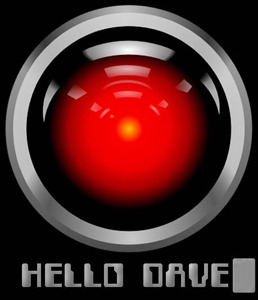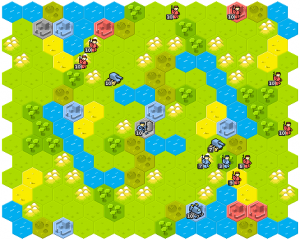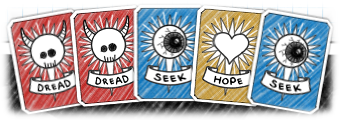Multiplayer vs Single Player: Opposite Design Goals

No matter how smart the AI, it's not the same as a human opponent!
As we design our first game we've been forced to look at the differences between how a single player game is played compared to a multiplayer (PvP) one. The goals of the player are often opposing, the rewards for playing are different, and how the player deals with setbacks is different. Since we are building a single player tactics game now but will later be expanding on it to deliver a multiplayer, PvP version this means we have to walk a difficult tightrope. We want the single player game to work and we want the gameplay to transition later on.
The Single Player Tactical Game
Our short term goal is to build a simple tactical turn-based game where you start with a team of rookies, and fight battles against the computer to progress. You can earn new skills for your units, and money to expand the team or buy better equipment in between battles. We also want to keep it as simple as possible so we can get a fully working game published and 'done'.
The Persistent PvP Tactical Game
Our long term goal is to build an exciting PvP tactics game with persistent units. Again you take control of a gang of recruits, poorly equipped and unskilled to begin with. The only way to advance your units is to take on other human players in tactical turn-based battles. As you win (or lose) games your units will gain skills and you will gain money to recruit more units or buy nicer toys for your existing ones.
Different Design Goals
Why is it so hard to make a game 'system' that will work well for both audiences? In both cases you need to keep individual battles tactical, fun, and challenging; you also want the longer term team-building in between battles to have depth and keep the player interested and wanting to play another battle.
In the single player game each battle is basically a puzzle: a tactical challenge where a clever player can easily outwit the computer AI. The difficulty level is ramped up by giving the computer more and more of an advantage in later battles, be that more units, better units or other ingame factors. The player is generally able to save & load their game, so if things go awfully wrong and they lose several units in one turn they will just load and try things a different way. You really want to avoid this: you want a game that can be played without constantly saving & reloading in case of mistakes, which effectively removes the challenge. Gregory Weir recently published an excellent column on failure, difficulty, and punishment in games that touches on this; worth a read.
This means removing (or minimising) some of the key things that have the opposite effect in a PvP environment. You need to make the game more arcadey and forgiving, and less nailbiting and random. For example, in the PvP game system when you take out a unit in battle there should be a small chance of permanent damage, be it death or some sort of crippling injury. In a PvP environment this is great fun! You have the fun factor of occasionally wrecking your opponent's best units while even if you are winning a battle you could lose a much-loved and skilled up unit at any time. Add in a community around the battles (like a forum) and you can mock & gloat, or vow revenge! This also only works in a PvP game as there is no mid-battle saving and loading; everything that happens is final.
Another thing that works well in a PvP tactics game but would only lead to frustration in the single player version is randomness. If you are playing against a human player and gain the upper hand in a game without any randomness you have effectively won the battle. It may take a while, but as long as neither player makes any tactical mistakes the game is going to go your way in the end. This makes it no fun for the losing player who is nevertheless forced to play out the game.

Weewar: blue has just ensured victory but the game goes on
A perfect example of this is Weewar, a fun web-based multiplayer clone of the Battle Isle series of games, which unfortunately suffers from this problem. Add in randomness (or at least a way to hide your units and surprise your opponent) and it's worthwhile for the losing player to play on; through either good luck or great skill they may be able to turn the battle around!
Our Approach
What we're going to do is go for a slightly more arcadey system for the single player game, and then add things like randomness and permanent unit removal into the mix when we develop the PvP game. One way of helping people transition between the rulesets would be to have an unlockable 'hardcore' mode available once you beat the single player game; this would enable permanent unit death and disable in-battle saving. Naturally it would be much harder (and more frustrating) – but you would only be playing it if you really like the game and it would both give the game replayability and let players get used to some of the ideas we want in the PvP version.
 Thanks for reading! Now check out Guild of Dungeoneering,
a game I'm making where you build the dungeon instead of controlling the hero! \o/
Thanks for reading! Now check out Guild of Dungeoneering,
a game I'm making where you build the dungeon instead of controlling the hero! \o/




2 Comments
[...] has a good post on the design aspects of multiplayer games vs single player games. It has some good tips if you're using both single player and multiplayer modes in your game. [...]
[...] Tony Pa) and 8bitrocket (here, here and here). – From the Gambrinous blog (new to this round-up) : Multiplayer v. Single Player: Opposite Design Goals – Sokay.net has a great new layout and look. – Edge Online's Future of Games is Flash Article – [...]